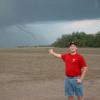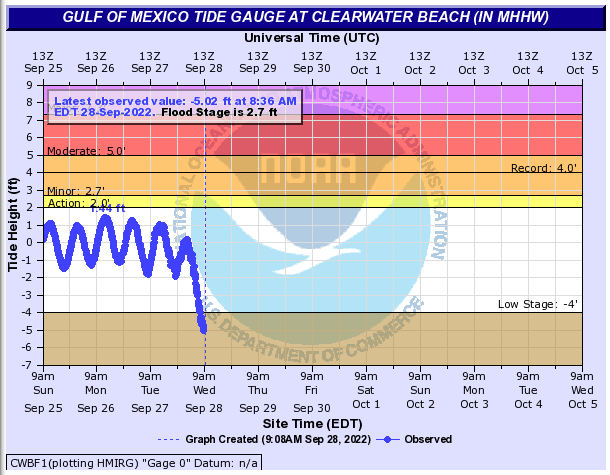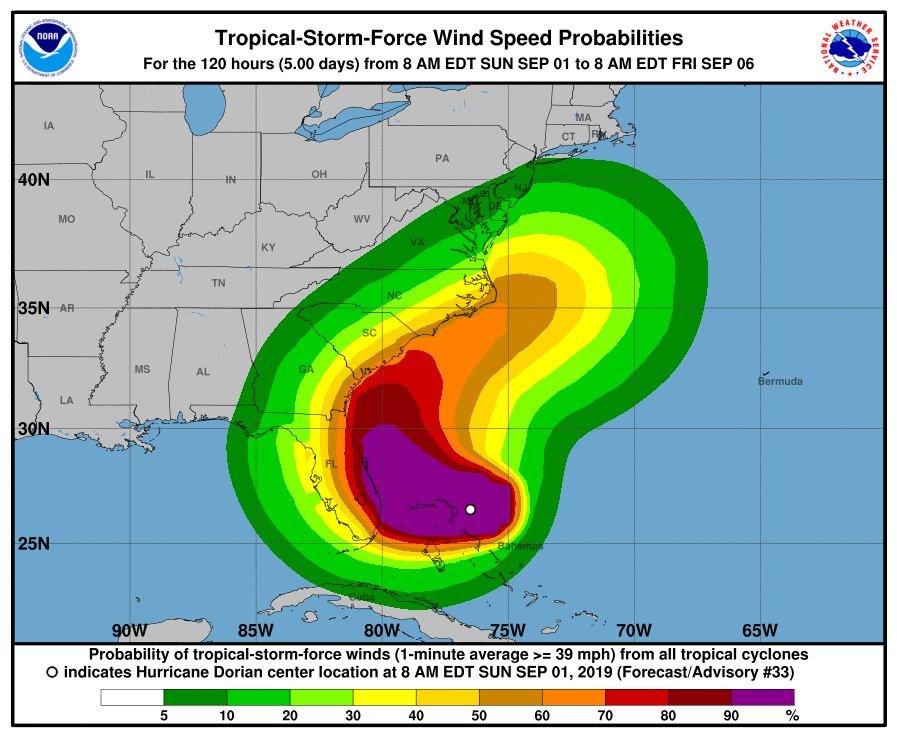-
Posts
279 -
Joined
-
Last visited
Content Type
Profiles
Blogs
Forums
American Weather
Media Demo
Store
Gallery
Everything posted by f2tornado
-
It's not the beatuty it was Wednesday morning but the coldest tops I've seen all day are sprouting near the center. We should see some enhancement as we get closer to the diurnal max. Model guidance ramps up the wind field in the right quad later tonight into the morning. Not exepecting much in the way of max wind increase but have a feeling the surge in Georetown vicinity could be fairly impressive given what must be a massive amount of IKE around this thing.
-
I didn't say that. I even said it's worthy of discussion (implying it's banter thread material). But, attributing one potent hurricane to climate change during a cold ENSO phase without supporting evidence is speculative junk "talking points" science.
-
Straight out of a talking points memo? A hurricane is weather, just like when someone in Chicago asks about that global warming when it's 20 below. That's weather too. Sea level rise is a worthy discussion, but not here, though I doubt the 2mm/yr rise changed the outcome much here.
-
Cape Coral cam definitely has water rising. https://www.webcamtaxi.com/en/usa/florida/capecoral-chiquitalock.html
-
-
Be careful what you wish for. The Hoover Dike around Okeechobee is widely considered one of the nation's most at risk to fail. Refer to the 1928 storm for a what if scenario.
-
-
Strongest radar echo about to hit the skyscrapers downtown NOLA. Can add an SS category for those winds. Bourbon Street cam doesn't look too crazy yet.
-
Bryan Norcross discusses this specific communication problem in a 2017 writing. This is a less elegant piece than I'm accustomed seeing from him. He has a number of good pieces easily found with a Google search showing where improvements in communication and could be warranted.
-
This will not be a popular opinion here. The BMX tweet would have been the end of it however ABC Nightly News turned the tweet into a hit piece on the President in an effort to stick him with a gaff. The President then lashed out at the reporter and the pile on began. I have rarely seen this kind of media passion to turn a nontroversy into a controversy. Consider the following published from BMX seven years ago AREA FORECAST DISCUSSION NATIONAL WEATHER SERVICE BIRMINGHAM AL 626 PM CDT THU AUG 23 2012 TROPICAL SYSTEMS ARE NEVER BORING OR EASY TO FORECAST AS ISAAC CONTINUES TO CHALLENGE. Kudos to the BMX forecaster who had the utmost confidence to publish an effective 0% forecast "no impacts... felt across Alabama" via Twitter in spite of the same office previously noting forecast difficulty with tropical systems. This conflicted, albeit slightly, with the NHC published probability distribution of TS winds covering a portion of AL. Further, it was somewhat inconsistent with the morning 9/1 Tallahassee AFD which covers southeast AL and stated, "The latest forecast for Hurricane Dorian from the National Hurricane Center continues to keep it east of the local area. While we still shouldn't let our guard completely down, the chance of impactful weather from Dorian occurring in our forecast area remains low". BMX should be no stranger to forecast uncertainty. Take a look at the forecast cone for Hurricane Isaac (2012) that at one time was nearly centered over BMX. In fact, the entire state of Alabama was enveloped within the cone before none of the state was in the cone. It should be noted, even though the entire state of Alabama was outside the forecast cone toward landfall, the Mobile area did experience some TS force gusts and impact from surge. The cone only represents the storm center forecast track. This is why NHC storm wind probabilities are smeared well outside the cone with time and why forecasters should be cautious speaking in absolute terms, particularly when the average error for a tropical system is about 200 miles on day 5.
-

Major Hurricane Florence: STORM MODE THREAD
f2tornado replied to stormtracker's topic in Tropical Headquarters
This is garbage. It's a Cat 2 with a very large wind field. The track has been almost dead on for the past week. The NHC was very conservative adjusting the track which worked in their favor for this storm. Perhaps they were a little too confident early on with their intensity discussion given all the inherent uncertainty (ERCs, shear, etc.) but they have consistently stated there would be some weakening as the the center approached the coast. Ultimately, a very large and dangerous storm is right where they forecast it to be. -

Major Hurricane Florence: STORM MODE THREAD
f2tornado replied to stormtracker's topic in Tropical Headquarters
Keep in mind this is a naturally very low spot that is prone to water on the road. That SUV is parked just past a permanently posted High Water sign. The local river is up a foot in recent days. -

Major Hurricane Florence: STORM MODE THREAD
f2tornado replied to stormtracker's topic in Tropical Headquarters
For perspective, Katrina was about 120 TJ at landfall and Sandy was around 140 TJ. Florence is seemingly increasing wind radii and IKE is likely increasing with time. Max winds are likely to decrease on final approach but, like Katrina, the wall of water is built up and the coastal bites will magnify it. Another comparison, the peak surge for Hugo 1989 was just over 20 feet. -

Major Hurricane Florence: STORM MODE THREAD
f2tornado replied to stormtracker's topic in Tropical Headquarters
Cloud tops of tropical cyclones do typically warm with daytime heating. The best lapse rates occur at night. We may see one more big burst tonight with the diurnal max in concert with crossing some of the highest ocean heat content. -

Major Hurricane Florence: STORM MODE THREAD
f2tornado replied to stormtracker's topic in Tropical Headquarters
Negative, aside from sparing locations further inland more wind/flood damage. The stall will allow for persistent surge through multiple tide cycles combined with feet of rain with nowhere to escape. The potential exists for a large swath of coast to be more or less obliterated. This is what Hazel 1954 did: "All traces of civilization on the immediate waterfront between the state line and Cape Fear were practically annihilated... every pier in a distance of 170 miles of coastline was demolished". -
-
A conservative think tank put together the climate change money trail in 2004. http://www.marshall.org/pdf/materials/289.pdf The epilogue before the numbers notes various concerns about the potential implications of the money trail.
-
The ocean has been warming for a 135 years. This is not a new phenomenon. Gouretski, V., J. Kennedy, T. Boyer, and A. Köhl (2012), Consistent near-surface ocean warming since 1900 in two largely independent observing networks, Geophysical Research Letters, 39, L19606, doi: 10.1029/2012GL052975. Roemmich, D., W. J. Gould, and J. Gilson, (2012), 135 years of global ocean warming between the Challenger expedition and the Argo Programme, Nature Climate Change, 2, 425-428, doi: 10.1038/nclimate1461.
-
I'm sure they play some limited role but am quite comfortable suggesting agriculture is a much bigger player for the region and quite possibly downwind through convective feedback. A couple years ago the dewpoint hit 88F in Moorhead, MN. That is not natural. That air is not gonna heat up or cool down readily. Having lived in various parts of the Plains all my life I can tell you there really aren't that many large contrails.
-
Correct. And these higher dewpoints increase SBCAPE (surface based convective available potential energy) for thunderstorms to potentially get juiced like Arod. The bulk of research suggests nocturnal temperatures are increasing at roughly twice the rate of afternoon temperatures on a global scale. This doesn't seem to apply to the irrigated Plains perhaps because of the artificially high peak transpiration of plants occurs during the afternoon. Clouds may very well have some role as well but I don't have any paper on that subject at my immediate disposal. Whatever is resulting from AGW in the Plains isn't coming from positive temp anomalies in the region unless you ignore all the data prior to circa 1980.
-
There has been no increased temperature trend east on the Rockies over the last 100+ years. There has actually been surface cooling. Temperature anomalies were pushing -1C until the past couple decades yet are still around -0.3C. These authors blame aerosols http://www.sciencedaily.com/releases/2012/04/120426155117.htm but I think the the much larger player is land use change which is strongly supported here: http://www.bama.ua.edu/~jcsenkbeil/appclim/mahmood%20et%20al.pdf All that irrigated corn might be the impetus for the increasing trend of heavy rain events in the Plains on east as well. Some quotes about it from researchers here: http://usatoday30.usatoday.com/weather/news/2007-07-23-crops_N.htm
-
It's already being attributed in some circles like Forecast the Facts (hyper alarmists), and at a minimum usually given the typical, "possibly enhanced through CO2 warming" quip. The basic premise is a warmer atmosphere can hold more water vapor. There has also been a marked increase in heavy rain events east of the Rockies since the late 70s. This makes it real easy for a person who has his mind set on climate change to connect these two but it's not that simple. Plains moisture largely comes from the Gulf or through evapotranspiration. Northern Gulf SSTs have been pretty stagnant over the past 100+ years which leaves ET which I can only assume had radically risen with irrigated agriculture and an increase in extreme transpiring crops like corn. Those mid 80s dewpoints in Iowa are not a natural phenomenon. It is quite possible this moisture is the source of increased heavy rain events east of the Rockies. Perhaps the PDO plays some role giving the timing of the ramp up in events. The attributing everything to CO2 climate change is annoying and downright lazy.
-

Historic Tornado Outbreak April 27, 2011
f2tornado replied to CUmet's topic in Weather Forecasting and Discussion
The Fujita scale was a wind scale. Fujita linked up the Beaufort scale with the Mach scale. The F-scale actually went to F12 (Mach 1) but F6 was considered inconeivable (nor would resulting damage be recognizable from F5). Since wind could not be directly measured it was inferred based on damage. Even Fujita, before his death, realized his scale was not relevent to cheaply built suburban housing, hence the EF scale.









